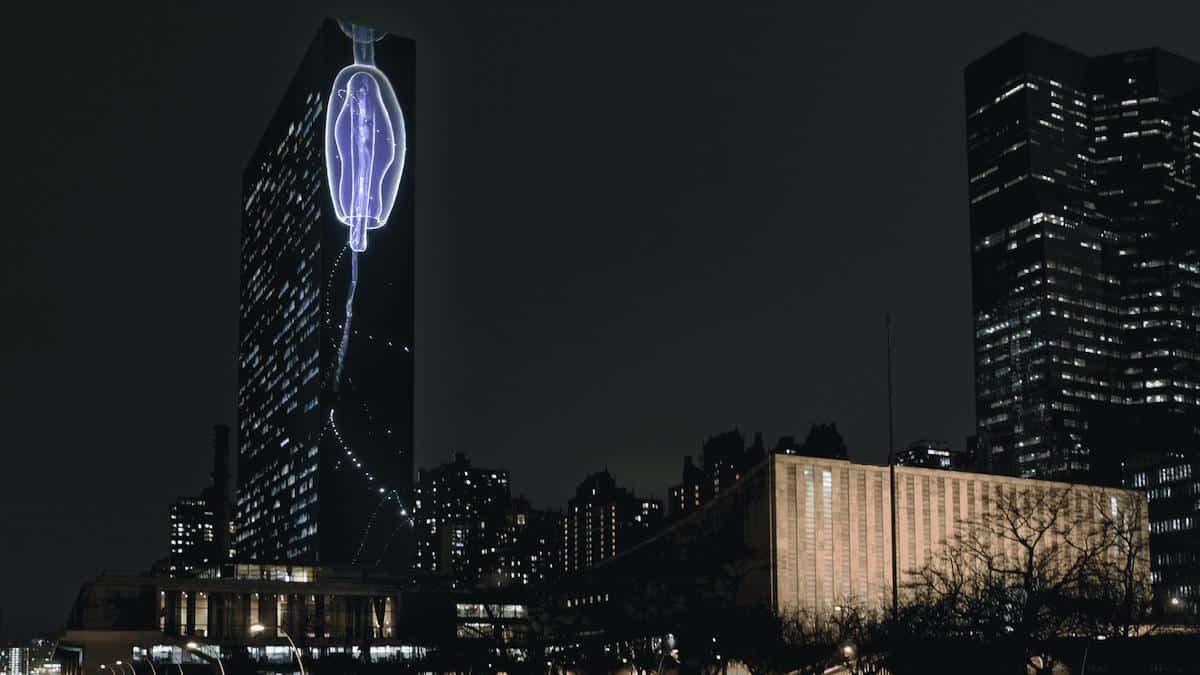
What’s a Siphonophore and Why Is There One on the UN This Week?
"These organisms make the earth habitable." Peter de Menocal, WHOI director

The image of a siphonophore was projected onto the facade of the United Nations' 505-foot tower from September 21 -24, 2021, coinciding with the 76th General Assembly and Climate Week NYC. Artist Rendering: UN Photo / Eskinder Debebe. Visualizations: SUPERFLEX.
This week, in honor of UN Climate Week, a Danish arts collective projected a siphonophore onto the UN Secretariat building in New York.
Starting Sept. 21 and continuing through the 24, the light projection danced more than 500 feet above the ground on the entire northern facade of the building to remind delegates and viewers of the many species on the planet that impact and are impacted by the climate crisis.
So, what is a siphonophore? Similar to a colony of coral polyps, siphonophores are also marine animals comprised of individual parts, called zooids, which function together and are genetically identical. The majority of siphonophores are long, thin and clear. In Apr. 2020, scientists in Australia discovered what they believe to be the longest animal in the world, a siphonophore potentially more than 390 feet long. The individual zooids work together as one, and these colonies are usually “gelatinous” and fragile, breaking under even the slightest force.
Most of these animals live in the twilight zone of the sea — deep, dark waters 200 to 1000 meters below the surface.
This little-known deep-sea creature is also a “critical agent of carbon removal from the atmosphere,” The New York Times reported. Siphonophores come up to the surface at night to feed when it is easier to hide from predators. They eat carbon-rich organisms before migrating down to hide when the sun comes up. In doing so, they sequester carbon that would otherwise be released into the atmosphere, the news report explained.
Every day, through this vertical migration, siphonophores bring carbon — in the form of their food — from the surface down to the twilight zone. According to Woods Hole Oceanographic Institute (WHOI), which partnered with the arts collective to produce the UN projection, this biological pump prevents carbon from returning to the air as a heat-trapping greenhouse gas. Instead, it is sequestered in biological material that can sink to the ocean’s depths. In the deep, as long as earthquakes and human activities like deep-sea mining or dredging don’t disturb it, this carbon can remain stored for thousands of years.
Just how much carbon can these little, clear animals help us store? The Times estimated that siphonophores sequester between two to six billion tons of carbon each year into the twilight zone. This is several times the amount of carbon emitted by all the world’s cars. WHOI estimated that roughly 90% of the carbon that gets into the twilight zone remains there, so siphonophores serve as a critical planetary carbon sink.
“The carbon pump that we’re talking about is tremendously important,” said Peter de Menocal, WHOI director. “If this disappeared, the atmospheric carbon dioxide would go up more than 50 percent. These organisms make the earth habitable.”
Vertical Migration, the actual piece projected onto the UN, focuses on the siphonophore as “a symbol of the many working as one,” a WHOI press release said.
“Unsettling our perceptions of scale and otherness, Vertical Migration is an intimate encounter with a life form that bears no resemblance to human beings, though we share a planet, an ecosystem, and a future, said SUPERFLEX in the release, the artists collective behind the illuminating work. “Because of sea-level rise, humans will also be migrating vertically in the coming centuries, to higher elevations and raised buildings. The siphonophore’s story is our story.”
Superflex also set up a ground-level installation of pink marble at Central Park called “Interspecies Assembly.” The 46-foot circle of seven large marble slabs has the words of a contract carved into them, the Times reported.
“By entering the circle of stones, you accept the contract to stay idle for at least five minutes,” Superflex co-founder Jakob Fenger told the Times. “To understand other creatures on the planet, you have to be quiet and listen.”
The pink marble is a nod towards the coralline algae that coral polyps eat and which tint coral reefs. The objective is to bolster awareness of all forms of life to protect biodiversity and boost climate action, the WHOI release said.
The installation, intentionally set up in Manhattan’s largest green space, requires humans to “temporarily slow down and actively listen to their co-species,” reported Resnicow and Associates. The park space is home to a rich array of flora and fauna, further emphasizing the organizers’ point.
Together, Vertical Migration and Interspecies Assembly represent something much bigger.
Markus Reymann, co-founder and director of TBA21 — Academy, who commissioned the works, told Resnicow that the piece represents an expression of hope in the face of the climate crisis — created not by people, but by nature itself.” He added, “By bringing this monumental SUPERFLEX piece to the iconic UN building during Climate Week NYC, we are demonstrating how artists and scientists can work together to spark awe and imagination as well as bringing greater awareness and conversation to trigger necessary collective action around urgent climate issues.”

 233k
233k  41k
41k  Subscribe
Subscribe 